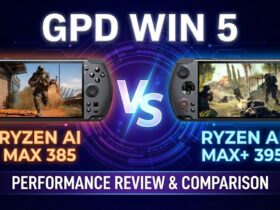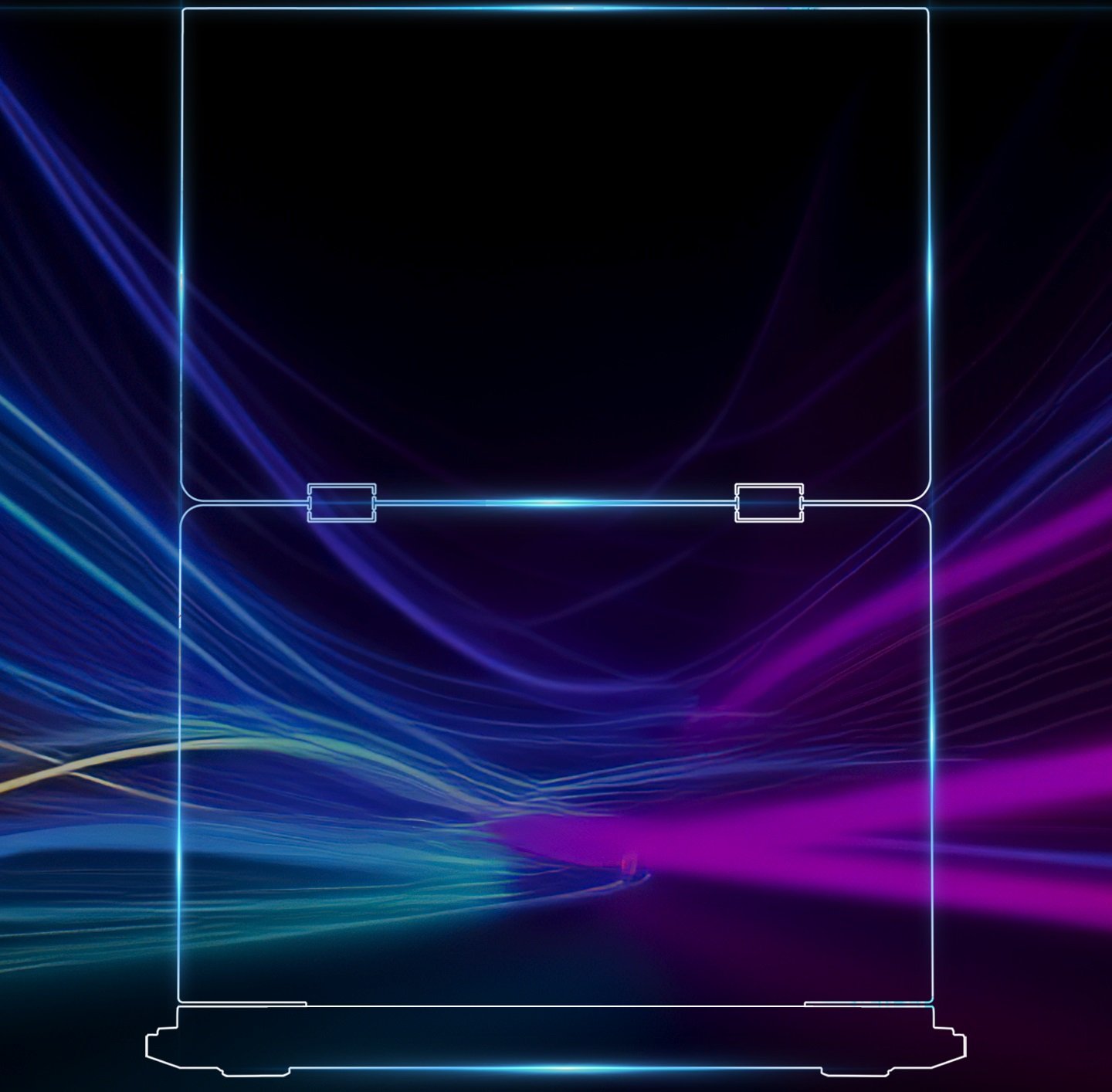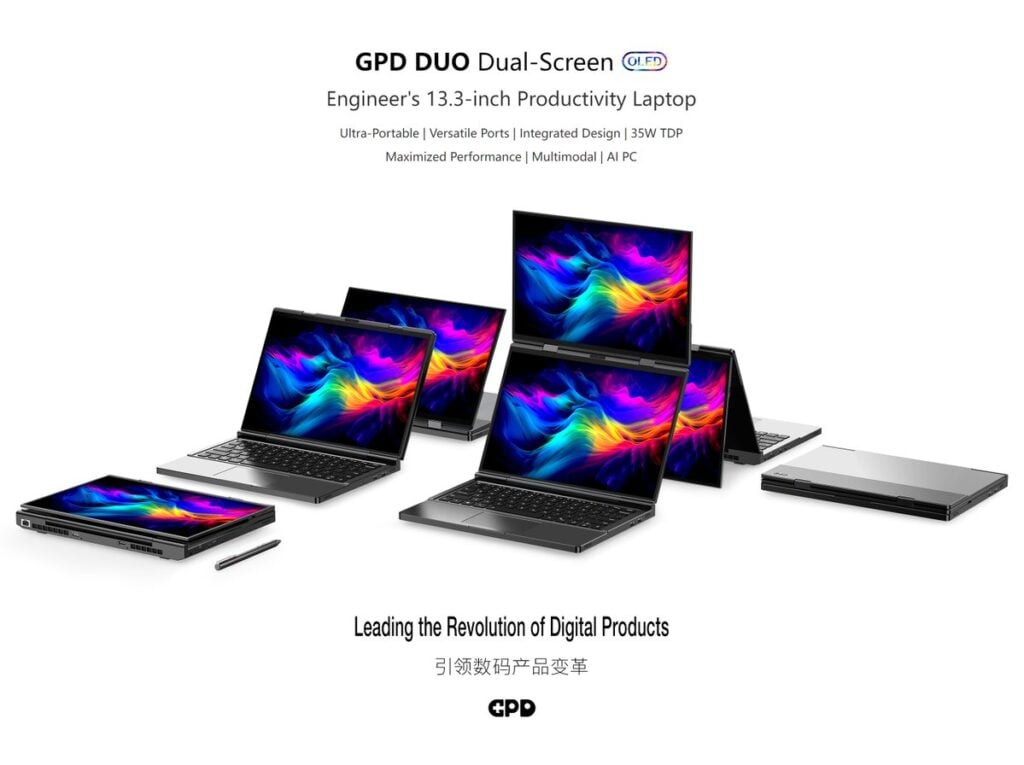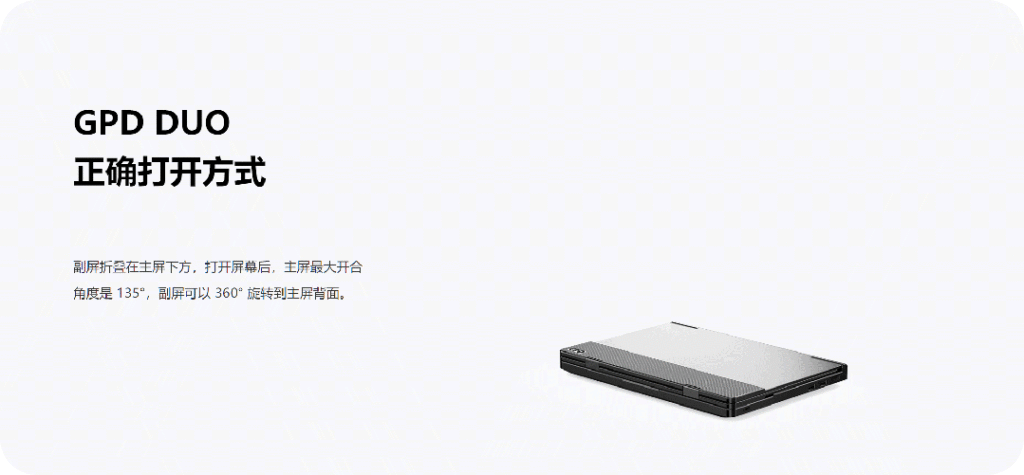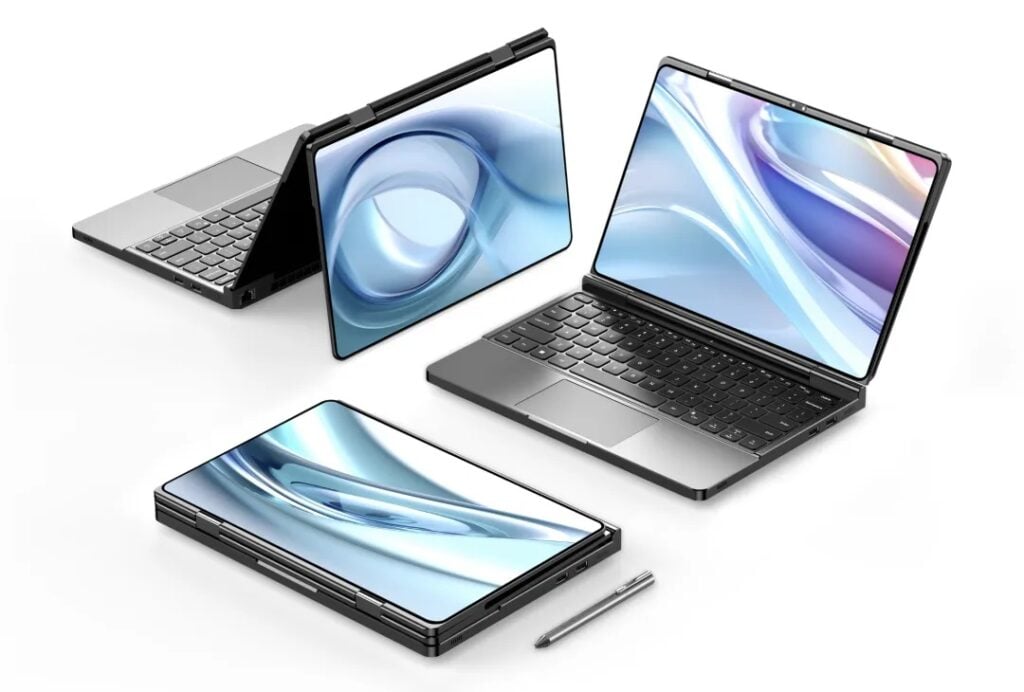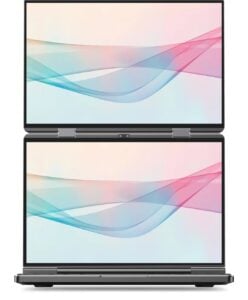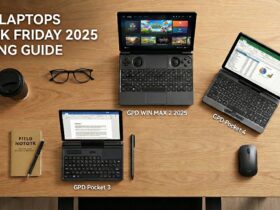GPD har ertet sin kommende bærbare datamaskin kalt GPD Duo som har to vertikale skjermer.
Opprinnelig startet det med at det bare ble vist et enkelt teaserbilde (nedenfor) av den nye GPD Duo. Det viser en base i laptop-stil og to vertikale skjermer. GPD nevner at skjermene vil være AMOLED med 10-biters fargedybde og 1,07 milliarder farger. I løpet av de kommende dagene vil vi oppdatere denne artikkelen med flere nyheter og informasjon så snart GPD kommer med dem.
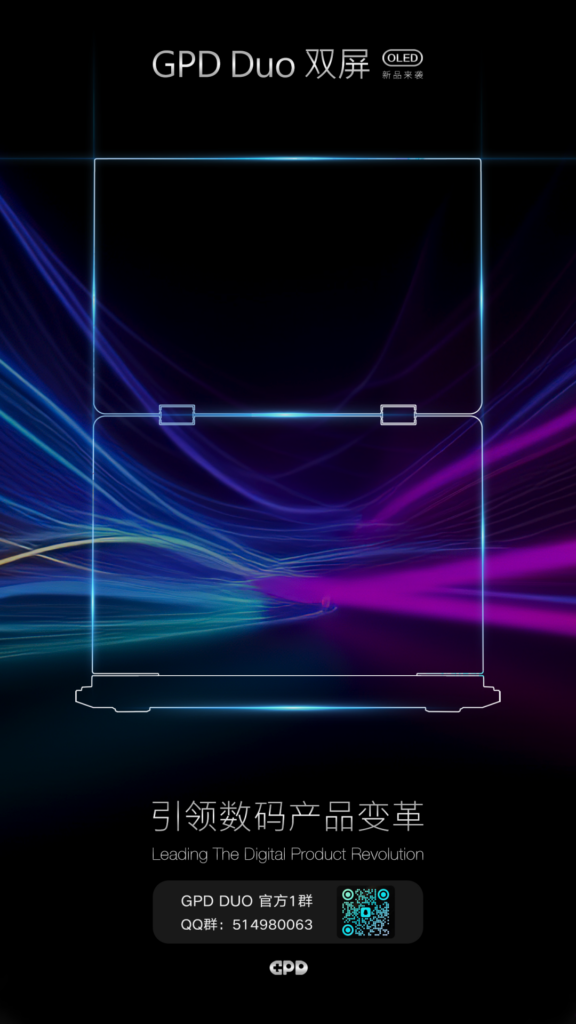
Hvis du husker tilbake til vår GPD-lekkasjeartikkel i fjor, ble det nevnt en enhet med to skjermer som ble kalt GPD P4 MAX. Denne enheten var forventet å ha en AMD Ryzen 7 7840U, så vi vil ta en gjetning om at GPD Duo kan ha den nyere AMD Ryzen 7 8840U i stedet.
I dag avslørte GPD et nytt bilde av GPD Duo-designet. For tradisjonell bruk av bærbare datamaskiner kan den andre skjermen foldes sammen med den primære skjermen, slik at den velkjente ergonomien opprettholdes. Når den andre skjermen vippes opp, får brukerne dobbelt så stor skjermplass, noe som øker produktiviteten og multitasking-mulighetene. I tillegg kan skjermene foldes flatt mot tastaturet, noe som gir en nettbrettlignende modus, selv om de er tykkere enn typiske nettbrett.
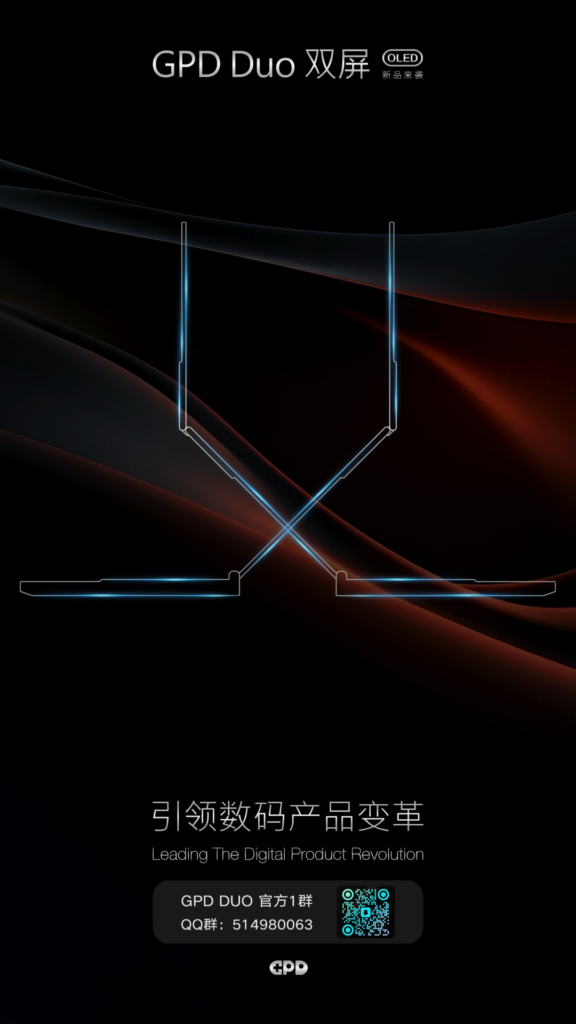
I en nylig oppdatering fremhevet GPD at Duo vil ha en integrert, tretrinns design. I motsetning til andre bærbare datamaskiner med to skjermer som er avhengige av eksterne Bluetooth-tastaturer eller trådløse tastaturer, som ofte lider av dårlig termisk ytelse og forsinkede innganger, lover Duo sømløs integrering og optimal ytelse. Enheten vil inkludere et fullt QWERTY-tastatur og en lett OLED-skjerm. Til tross for de to skjermene forblir enheten balansert og kompakt, noe som reduserer faren for at den velter.
GPD Duos skjermer
GPD DUO er en banebrytende bærbar PC med to skjermer som er utformet for å møte behovene til designere, utviklere og kontorfolk. Denne innovative enheten har en 13,3-tommers AM-OLED-skjerm med to originale OLED-paneler fra Samsung, som gir 10-biters fargedybde og 1,07 milliarder farger for overlegen bildekvalitet.
Skjermene har et skjermforhold på 16:10, en oppløsning på 2880 x 1800 og 255 PPI, med funksjoner som 60 Hz oppdateringsfrekvens, 10-punkts berøring og trykkfølsomhet på 4096 nivåer som er kompatible med Surface Pen-pennen. Dette oppsettet sikrer høy fargenøyaktighet med 100 % Adobe RGB- og 133 % sRGB-fargespekterdekning, noe som gjør den ideell for profesjonelt designarbeid. I tillegg har skjermene et kontrastforhold på 1 000 000:1 og nesten null nits svart for ekte svart og levende hvitt, noe som forbedrer både film- og spillopplevelsen.
GPD DUO er designet for optimal ytelse og bærbarhet, og er utstyrt med robust maskinvare som maksimerer produktiviteten og spillmulighetene, og kan konkurrere med avanserte bærbare spill-PC-er. Den har en integrert design med et ikke-avtakbart tastatur, slik at du slipper å bruke upålitelige trådløse eksterne enheter. Enheten har minst 2 M.2-porter for utvidbar lagringsplass på opptil 16 TB, og støtter opptil 96 GB RAM for å legge til rette for utviklingsmiljøer på tvers av plattformer.
OLED-skjermene er ultratynne og lette, noe som gjør at hele enheten, når den er brettet sammen, er på størrelse med et A4-papir og passer komfortabelt i en skulderveske. Med en maksimal lysstyrke på 500 nit og en responstid på 1 ms for gråtoner lover GPD DUO skjermytelse på e-sportsnivå, noe som gjør den til et allsidig verktøy for ulike scenarier, fra kontoroppgaver til avanserte spill og kreative prosjekter.
Valg av AMD Ryzen 7 eller 9 CPU
GPD Duo vil være tilgjengelig i to kraftige modeller som passer til ulike ytelsesbehov. Den første modellen er utstyrt med AMD Ryzen 7 7840U-prosessoren, som gir utmerket ytelse for multitasking og hverdagsbruk. For de som ønsker enda mer kraft, kommer den andre modellen utstyrt med AMD Ryzen 9 HX 370, som leverer topp ytelse for krevende applikasjoner som spill, innholdsskaping og tung multitasking. Enten du trenger en balansert maskin eller et bærbart kraftverk, har GPD Duo det du trenger.
RAM- og lagringsalternativer
GPD Duo tilbyr fleksible RAM- og lagringskonfigurasjoner for å dekke en rekke ulike brukerbehov. Du kan velge mellom 16 GB (8840U), 32 GB eller 64 GB (HX 370) LPDDR5X RAM, noe som sikrer ultrarask multitasking og ytelse på tvers av programmer.
GPD Duo har lagringsalternativer fra 512 GB (8840U) til 1 TB og 2 TB (HX 370) med høyhastighets NVMe PCI-E Gen 4.0 SSD-lagringsplass, noe som gir rikelig med plass til filer, spill og media, med lynrask datatilgang. I tillegg har enheten et SD-kortspor for enkel utvidelse av lagringsplassen.
En titt inn i GPD Duo RnD
GPD ga en oppdatering om forskning og utvikling av GPD Duo.
Vi har sett at stadig flere designere og utviklere tar i bruk oppsett med to skjermer i arbeidet, men disse oppsettene er ikke bærbare. Selv om det finnes skjermer med to skjermer på markedet, er skjermene og hovedenheten separate, noe som gjør dem upraktiske å bære med seg. På den annen side er produkter som integrerer skjermen og hovedenheten i et oppsett med to skjermer, helt klart ikke i tråd med etterspørselen i markedet. De har alle en delt design, noe som krever et eksternt Bluetooth-tastatur.
Ideen om å integrere skjermen og hovedenheten kommer fra nettbrett, mens konseptet med doble skjermer kommer fra sammenleggbare smarttelefoner. Men hvis prosessorer som 185H og 1355U skal gjøres om til nettbrett med en ekstra skjerm samtidig som de er ultratynne, må man ofre kjøling og ytelse. Ikke bare sløser man med CPU-en, men alle som har brukt den vet hvor svak den er som produktivitetsverktøy.
Vi har som mål å skape et produkt som virkelig oppfyller brukernes behov!
1. For det første må det ha en integrert design, uten skille mellom tastaturet og hovedenheten. Bluetooth og trådløse tastaturer og mus er på mange måter dårligere enn kablede tastaturer og mus. Virtuelle tastaturer er bare en provisorisk løsning for enkle oppgaver; ingen tror vel på alvor at et nettbrett pluss tastatur eller en telefon pluss WeChat er et produktivitetsverktøy!
2. Ytelsen må maksimeres for å utnytte maskinvarepotensialet fullt ut. Enten den skal brukes til spill eller kontorarbeid, bør den ha samme ytelse som en bærbar spill-PC!
3. Den må bruke de beste OLED-skjermene, og den må ha to skjermer. Den bør ha responshastigheter på spillnivå og være en innfødt 10-bits skjerm med 100 % Adobe RGB-fargespekter for å oppfylle de profesjonelle behovene i designbransjen. Den må også ha trykkfølsomhet og naturlig håndskrift for å sikre mer detaljerte tegneeffekter som erstatning for grafikkbrett!
4. Den bør ha omfattende porter med de sterkeste utvidelsesmulighetene, slik at du kan koble til et eksternt grafikkort!
5. Den bør ha støtte for minst to M.2-spor. Ved å velge SSD-er med den høyeste kapasiteten som er tilgjengelig på markedet, bør enheten kunne utvides til 8 TB eller 16 TB lagringsplass! Minnet kan nå opp til 96 GB, med sikte på å skape et utviklingsmiljø for flere systemer og flere IDE-er som kjører på tvers av plattformer for brukere av virtuelle maskiner!
6. Den må ha en batterilevetid som kan konkurrere med alle dagens high-end ultrabooks!
7. Den må være bærbar, på størrelse med et A4-ark, slik at den kan bæres i en skulderveske av kvinner og brukes til arbeid på farten!
8. Som AI-PC må den ha kraftig datakraft, lagringskapasitet og evne til multimodal interaksjon!
Endelig må den kunne tilpasses ulike scenarier, og ikke bare begrense seg til å være en bærbar datamaskin! Den sekundære skjermen kan for eksempel kobles til en tredjeparts hovedenhet for arbeid eller spill, og i nettbrettmodus kan den blant annet kjøre Linux eller macOS!
Dette er GPD DUO, en produktiv bærbar PC med dobbel 13,3-tommers skjerm som ingeniører sannsynligvis vil elske
[azp_custom_product id="38″]





